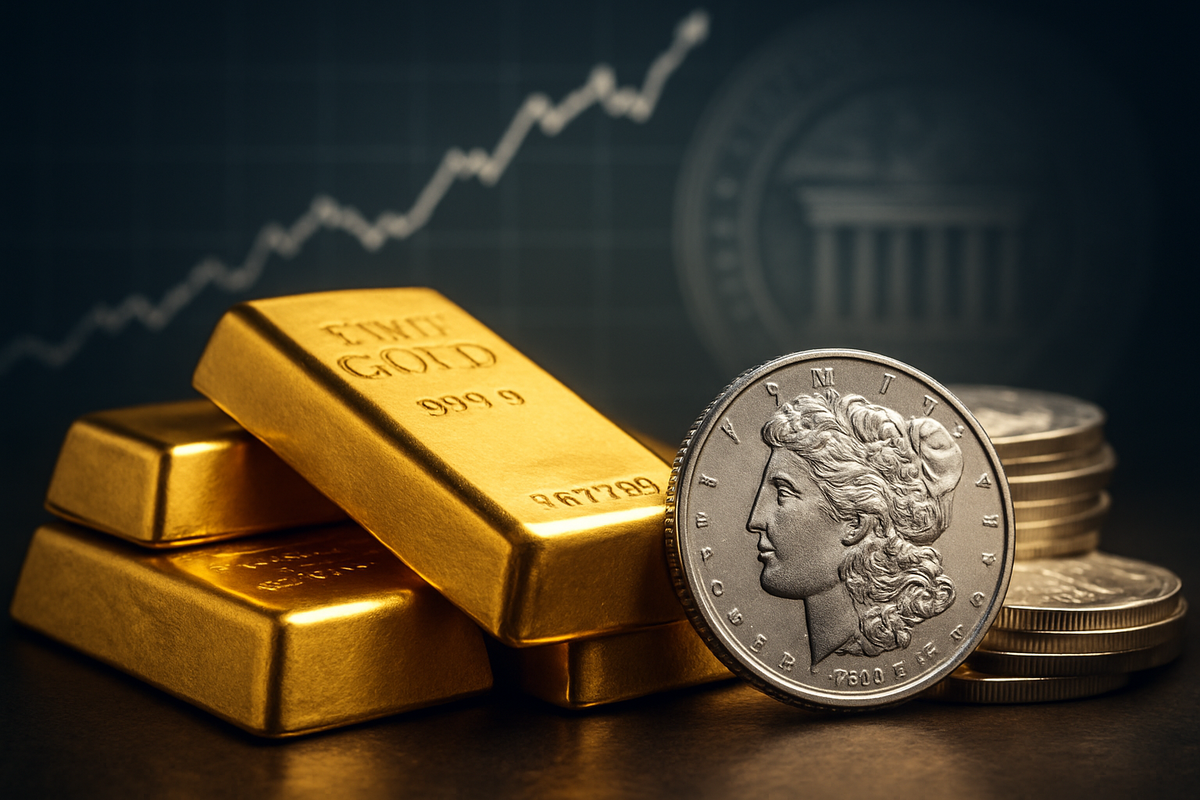
Precious metals are currently experiencing a remarkable surge, with gold charting its fourth consecutive monthly gain and poised for its best annual performance since 1979. Even more dramatically, silver has surged to fresh all-time record highs, breaking above the $55 per ounce mark. This robust rally, unfolding in late 2025, is primarily fueled by escalating market expectations of a significant dovish pivot from the U.S. Federal Reserve, coupled with persistent safe-haven demand and acute supply constraints in the silver market.
The immediate implications of this rally are profound, signaling a sustained bullish momentum for precious metals and prompting a widespread re-evaluation of investment strategies. As investors increasingly gravitate towards alternative assets in anticipation of a lower-yield environment, the weakening U.S. dollar makes dollar-denominated gold and silver more attractive globally. This environment reduces the opportunity cost of holding non-yielding assets, further bolstering their appeal amidst a landscape of geopolitical uncertainties and economic shifts.
Unprecedented Ascent: Gold and Silver Reach New Heights
The year 2025 has been nothing short of historic for precious metals. Gold prices have witnessed a spectacular ascent, breaching the $4,100 per ounce threshold in late November and hovering between $4,132 and $4,211.82 per ounce. The yellow metal had already established an all-time high of $4,379.13 (or $4,381.58) per ounce on October 17, 2025, contributing to an impressive year-to-date gain of approximately 58% to 60%. Silver's performance has been even more stellar in percentage terms, with spot silver surging to fresh all-time record highs on November 28, 2025, reaching as high as $55.30 to $55.76 per ounce in London, surpassing its previous record of $54.48 or $54.50 per ounce set on October 17, 2025. Silver boasts an astonishing year-to-date gain exceeding 81%.
The timeline leading up to this moment reveals a rally that has gained significant traction throughout 2025, accelerating notably in the fourth quarter, particularly in October and November. A pivotal moment was the U.S. Federal Reserve's October 2025 policy statement, which unequivocally signaled a shift towards monetary easing, culminating in an initial 25-basis-point interest rate cut. Market traders are now assigning a high probability, ranging from 79% to 87%, to a further 25-basis-point rate cut by the Federal Reserve at its upcoming December meeting, with additional cuts anticipated well into 2026. This aggressive repricing of future interest rates has been a primary catalyst for the precious metals boom.
Key players reinforcing these dovish expectations include a chorus of Federal Reserve officials, such as New York Fed President John Williams, Mary Daly, Christopher Waller, and Stephen Miran, whose recent remarks have consistently pointed towards lower borrowing costs. Furthermore, recent underwhelming U.S. economic data, including softer labor market readings, cooling inflation signals, weaker-than-expected retail sales, and a steady Producer Price Index, have bolstered the argument that current monetary policy may be overly restrictive. Speculation surrounding White House economic adviser Kevin Hassett as a leading candidate to succeed Jerome Powell as Fed Chair has also fueled expectations of an even more aggressive easing cycle, given Hassett's known advocacy for faster and deeper rate cuts.
Beyond monetary policy, robust institutional and central bank buying has provided a strong foundational demand for gold. Central banks globally are projected to acquire over 900 tons of gold in 2025, strategically diversifying away from U.S. dollar reserves and hedging against geopolitical risks. The silver market, meanwhile, is grappling with its fifth consecutive structural deficit in 2025, despite a decline in overall demand categories. Chinese silver inventories have plummeted to their lowest levels in a decade, indicating a tight market that has significantly contributed to silver's exceptional price surge. Initial market reactions on November 28, 2025, were characterized by erratic price movements and thin liquidity, partly due to a technical halt on the CME Comex Exchange, underscoring the intensity and volatility of the current trading environment.
Companies Poised to Win or Face Challenges in the Precious Metals Rush
The unprecedented rally in gold and silver is creating a distinct landscape of winners and those facing challenges across the public market, particularly within the mining, refining, and investment fund sectors.
Gold and silver mining companies are broadly positioned to be significant beneficiaries of the precious metals rally. The principle of operating leverage dictates that as commodity prices rise, revenues increase at a faster rate than relatively fixed production costs, leading to substantially higher profit margins, cash flows, and earnings. This can translate into increased earnings per share, stronger balance sheets, and potentially higher dividend payouts. Companies like Newmont Corporation (NYSE: NEM, TSX: NGT), the world's largest gold miner, and Barrick Gold Corporation (NYSE: GOLD, TSX: ABX) are expected to see improved revenue streams and profitability. Canadian producers such as Agnico Eagle Mines (NYSE: AEM, TSX: AEM) and Alamos Gold Inc. (NYSE: AGI, TSX: AGI) have already demonstrated significant increases in earnings and free cash flow. For silver, pure-play miners like Pan American Silver Corp. (NASDAQ: PAAS), billed as the world's premier silver mining company, and First Majestic Silver Corp. (NYSE: AG) are highly leveraged to rising silver prices, poised for dramatic upside. Precious metals streaming companies like Wheaton Precious Metals Corp. (NYSE: WPM) are also major winners, as they purchase future production at fixed, low prices, amplifying their margins significantly without direct exposure to mining operational costs.
Conversely, some mining companies, particularly those with high All-in Sustaining Costs (AISC) or those plagued by operational setbacks, geopolitical instability in their operating regions, or declining ore grades, may struggle to fully capitalize on the rally. While higher prices can make lower-grade ore economically viable, it can also paradoxically increase processing costs and energy consumption. The refining sector, especially for silver, faces a more bifurcated outlook. Silver refiners have encountered a temporary liquidity crisis with exceptionally high silver lease rates, making it uneconomical to fund the metal during processing. Some have temporarily paused buying scrap silver, and borrowing costs have surged, indicating immediate supply scarcity and putting significant stress on the refining system. Gold refiners, however, do not appear to be facing the same level of stress.
Investment funds, particularly Exchange-Traded Funds (ETFs) that hold physical gold and silver bullion, are direct beneficiaries. Funds like SPDR Gold Shares (NYSE Arca: GLD) and iShares Silver Trust (NYSE Arca: SLV) offer convenient exposure to rising prices and are expected to see increased inflows as investors seek portfolio diversification, inflation hedges, and protection from currency debasement. ETFs focused on gold and silver mining companies, such as the Sprott Active Gold & Silver Miners ETF (NASDAQ: GBUG) or the Global X Silver Miners ETF (NYSE Arca: SIL), also offer leveraged exposure to price movements. These funds benefit from the general bullish sentiment and the increased investor appetite for precious metals as a hedge against global economic uncertainties and a weakening U.S. dollar.
Wider Significance: A Structural Shift in Global Finance
The current surge in gold and silver prices signifies more than just a cyclical upswing; it reflects a profound and potentially lasting structural shift in global financial markets. This rally, driven by dovish Federal Reserve expectations and persistent supply constraints, is unfolding amidst a complex tapestry of global economic uncertainty and geopolitical tensions, prompting a fundamental re-evaluation of precious metals as both a store of value and an industrial necessity.
This event fits into broader industry trends characterized by increasing safe-haven demand, persistent inflation concerns, and a significant trend of central bank accumulation. Central banks globally have been aggressively increasing their gold reserves, with annual purchases consistently exceeding 1,000 tonnes since 2022. This strategic accumulation is a diversification strategy, a move away from U.S. dollar-centric reserves, and a hedge against sovereign risk. For silver, its dual role as a monetary and industrial metal is critical. Robust demand from green technologies—including solar cells, electric vehicles (EVs), and advanced electronics—is a powerful long-term driver, with EVs, for instance, requiring substantially more silver than conventional vehicles.
The ripple effects are widespread. While mining companies generally benefit from higher prices, industrial users of silver, such as solar panel manufacturers and electronics companies, face increased input costs, potentially necessitating hedging strategies or material science innovations. The rally also highlights regulatory and policy implications. The Federal Reserve's actual policy decisions remain paramount; any unexpected hawkish shift could temper the bullish trend. Moreover, the substantial central bank gold accumulation underscores a strategic restructuring of global reserves, signaling a long-term de-dollarization effort. Environmental regulations and lengthy permitting processes also contribute to supply constraints, limiting the industry's ability to respond quickly to increased demand.
Historically, the current market exhibits striking parallels with the 1970s bull market, a decade marked by double-digit inflation, oil shocks, and a loss of confidence in fiat currencies. During that period, gold surged approximately 2,300%, and silver rallied by about 3,200%. Key similarities include breakouts from multi-decade price bases, secular bear markets in bonds, intensified central bank gold accumulation, and persistent inflation. The current rally is also seen as a distinct phase influenced by the post-COVID era of unprecedented stimulus, global debt overload, and increasing geopolitical fragmentation. Silver, with its smaller market capitalization and dual demand profile, often demonstrates greater volatility and leverage compared to gold, leading to more pronounced price movements during such periods.
What Comes Next: Navigating a Bullish Horizon
The trajectory for the precious metals market, particularly gold and silver, appears robustly bullish in the short to medium term, largely contingent on the Federal Reserve's monetary policy and ongoing global dynamics. As of late 2025, the stage is set for continued price appreciation, though investors and companies must remain agile in their strategies.
In the short term (next 6-12 months into 2026), if the Fed implements the anticipated December rate cut and maintains a dovish stance, gold and silver are expected to sustain their upward momentum. Deutsche Bank has raised its 2026 gold price forecast to $4,450 per ounce, with some analysts eyeing $5,000 by mid-2026. For silver, Metals Focus anticipates an average of $57 next year, potentially hitting $60, while Bank of America expects it to reach $60 per ounce, averaging $56.25. Robust demand from central banks and investors, coupled with persistent supply challenges from labor and equipment shortages, are expected to provide fundamental price support.
Long-term possibilities (beyond 2026-2027) remain equally compelling. Deutsche Bank forecasts gold at $5,150 per ounce in 2027, with the World Bank projecting elevated precious metal prices through 2026. Macroeconomic underpinnings such as persistent global inflation, historically compressed real yields, and increasing global debt accumulation create an environment structurally favorable for precious metals as a hedge against currency debasement. Structural demand shifts, including major financial institutions recommending 15-20% allocations to precious metals and accelerating central bank gold accumulation, are creating a new demand paradigm. The global transition to green energy will also continue to drive long-term industrial demand for silver, platinum, and palladium.
Strategic pivots are essential for both investors and companies. Investors should consider systematic accumulation, potentially increasing their allocation to precious metals (e.g., Morgan Stanley's suggested 60% stocks, 20% bonds, 20% gold strategy) for diversification and as an inflation hedge. Diversifying across different precious metals and utilizing ETFs or physical bullion are also key. Mining companies should accelerate exploration and development projects to capitalize on higher prices, while focusing on sustainability (ESG) and technological innovation. Supply chain resilience will also be paramount as geopolitical instability prompts nations to secure strategic reserves.
Market opportunities include new demand sectors from green energy and AI, and potentially innovative financial products. Challenges, however, include potential monetary policy reversals if the Federal Reserve turns hawkish unexpectedly, increased regulatory scrutiny from excessive volatility, and the inherent lag in mining supply response. Demand destruction, particularly in the jewelry market, could also emerge from sustained high prices. Potential scenarios range from a "Goldilocks" environment of continued rate cuts supporting prices, to a turbulent environment where heightened geopolitical risks further amplify safe-haven demand. Even potential price corrections are viewed by some as strategic accumulation opportunities within an overarching structural bull market.
Comprehensive Wrap-up: A New Era for Precious Metals
The year 2025 has undeniably marked a new era for precious metals. Gold's sustained rally, comfortably above $4,000 per ounce and heading for its best annual performance since 1979, alongside silver's explosive surge to fresh all-time highs above $55 per ounce, are not isolated events. They are symptoms of a profound re-evaluation of wealth preservation and investment strategies in a complex global economy.
The key takeaways from this rally are clear: dovish Federal Reserve expectations, persistent inflationary pressures, escalating geopolitical instability, a weakening U.S. dollar, record central bank demand, and robust industrial demand for silver (especially from green technologies) have converged to create a potent bullish environment. These interconnected factors underscore the enduring appeal of gold and silver as tangible assets in times of uncertainty.
Moving forward into 2026, the market assessment remains broadly bullish. Expectations of further Federal Reserve rate cuts, coupled with persistent macroeconomic tailwinds and strong demand pillars from central banks and industrial sectors, are likely to maintain upward price momentum. Analysts project continued price appreciation for both gold and silver, with many anticipating silver will continue to outperform gold due to its robust industrial fundamentals and smaller market capitalization. This signals a structural bull market for precious metals, cementing their role as essential components for portfolio diversification and wealth preservation.
This rally signifies a lasting impact on global finance, as precious metals are increasingly viewed as core inflation hedges and crucial diversifiers. The endorsement of higher gold allocations by major institutions highlights a seismic shift from traditional asset allocation models, suggesting that the current macroeconomic conditions and geopolitical realities have established a long-term trend. Investors should watch for shifts in Federal Reserve policy, inflation and economic data, geopolitical developments, U.S. dollar movements, central bank buying trends, and industrial demand for silver. While the appeal of precious metals remains strong, a modest allocation (typically 5% to 10% of a portfolio) and dollar-cost averaging are advised to mitigate risk, especially given silver's higher volatility.
This content is intended for informational purposes only and is not financial advice


















